The Common Vein Copyright 2011
Introduction
When the force applied to the bone exceeds the strength of the bone
Thus there are two factors to consider – the force and the bone
The force
type
direct
bumper injury
crush
penetrating
indirect (acting from a distance)
traction
rotational
compressive
magnitude
direction
duration
Character of the bone
density
strength
elasticity
absorbing capacity
Blunt Trauma
Penetrating Trauma
Bending Forces
Bending fractures occur after a force applied to a specific focal region overcomes the elastic limit of the bone, resulting in a cortical break on the opposite side of the force due to tensile forces on the tissues.
The periosteum on the side of the compressive force usually remains intact. The resulting fracture is usually transverse or oblique, but may have a butterfly fragment.
The bending force can also be conceptualised by using the principles on the bending forces that occur to a tree branch by the wind or a heavy weight such as from heavy wet snow on the branches. The following series of images explains the compressive and tensile forces as applied to a fractured branch
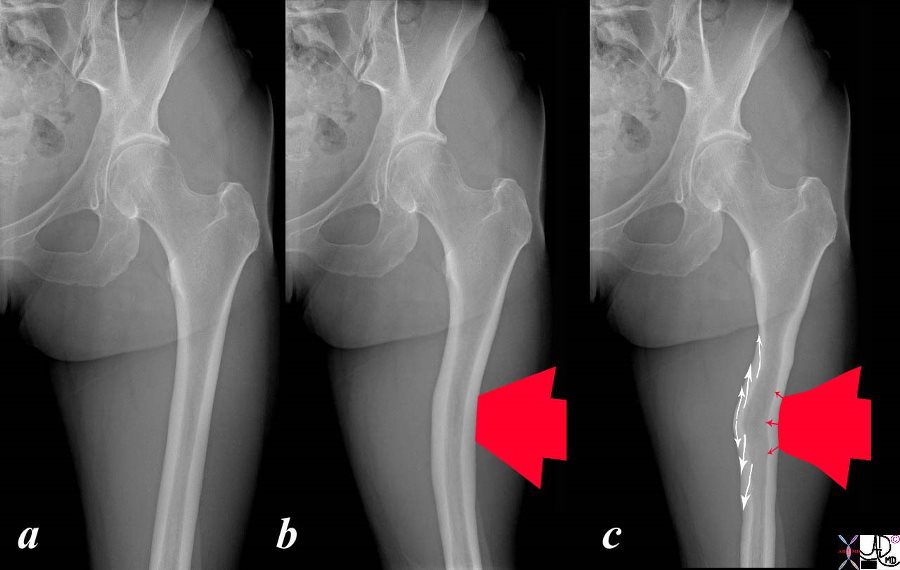
This A-P examination of the proximal left femur shows the forces that are generated when a bending injury occurs after a sudden forceful (large red arrow with cut off tip) pressure is exerted on the shaft of the femur (b) resulting in bending or compressive forces on the near side of the force (small red arrows c) and then spread out laterally resulting in tensile (pulling forces) on the far end of the bone (white arrows c). There are therefore two resultant vectors almost at right angles to each other forming almost a ?T? shape.
Courtesy Ashley Davidoff Copyright 2011 103491c01L1.9s

Compressive and Tensile Forces
The series of images show the initial force on the bone (large red arrow in a) followed by the compressive force (small red arrows b) on the ipsilateral side of the injurious force. As the force gets transmitted through the bone tensile forces (white arrows in c) cause a distraction of the fibres of the bone.. When a pressure is applied to a long bone at an approximate right angle vector a pliable structure like bone will bend having a concave shape on the receiving end of the force and a convex shape on the opposite surface The forces on the concave side are compressive and on the opposite convexity they are tensile.(Latin tendere – to stretch).
Courtesy Ashley Davidoff Copyright 2011 106647p.84cL.91L
The parallel is particularly poignant since the bark of the tree particularly when young is similar to the periosteum.

This photograph shows a splintered transverse fracture of a small branch of a tree showing a varus deformity if considered the right femur for example, but a valgus deformity if considered the left femur. The fracture is not complete with the medial edge (of a right sided fracture) remaining intact, held in place by the bark ? the equivalent of the periosteum. The periosteum will remain intact on the side of the force while tearing occurs over the fracture on the opposite side.
Courtesy Ashley Davidoff Copyright 2011 107342pb03.8

This photograph shows bowing of a small branch of a tree without any distinct fracture. This type of traumatic deformity is seen only in the pediatric population reflecting the softer and more pliable nature of bone. The intact inner concave edge is the site of impact and the outer convex edge is on the opposite side of the impacting force. This image exemplifies a greenstick fracture.
Courtesy Ashley Davidoff Copyright 2011 107345pb01.8
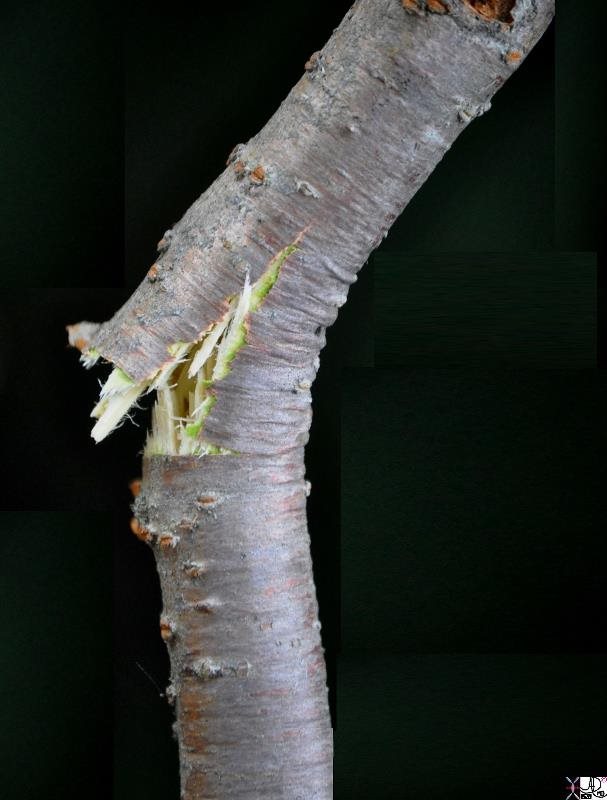
This photograph shows an incomplete splintered transverse fracture of a small branch of a tree The intact inner edge is usually the site of impact and the outer fractured edge edge is on the opposite. This image exemplifies a greenstick fracture characteristically seen in the pediatric population where bones are more pliable and less brittle.
Courtesy Ashley Davidoff Copyright 2011 107344pb01.8
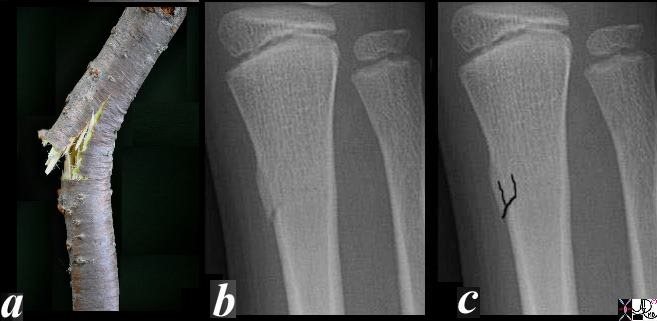
If the force does overcome the resilience of the bones but just by a little, then an incomplete fracture results on the opposite side of the force (a). This image (a) shows the shows the incomplete fracture of a young branch (greenstick) that has been subjected to a bending force that was able to overcome the resiliency of the branch. Because it was so soft a complete fracture was not accomplished despite considerable force. The X-ray (b,c) shows a simple greenstick fracture of the distal shaft the radius of a 9month old child. Image b shows the fracture overlaid in black to enable better appreciation of the fracture. In this young patient (b,c) the side distal to the force shows both horizontal and vertical components to the greenstick fracture (overlay in black in c). This X-ray shows a greenstick fracture of the shaft of the radius in a young child (b,c). Greenstick fractures occur in young patients when the combination of less brittle and more elastic bone and relatively mild bending force results in the incomplete fracture rather than a frank through and through complete break. The softer bones of children allow the bone to yield to the force. The name ?greenstick? is used since the shape changes are reminiscent of the shape changes and fracture lines that occur with a young pliable branch of a tree. When such a branch is subjected to a breaking force it results in one of three fractures. The first is a transverse break on one side and extending along the long axis of the bone and without traversing the full width of the bone. This is an example of that type of greenstick fracture. The others are bowing deformities and torus or buckle fractures.
Courtesy Ashley Davidoff Copyright 2011 107344pb01.8 s 100074c01.81L02.8s
For the spine think of flexion, extension, compression/axial load, and shearing/rotation.
Torsional Forces
Torsional forces occur when there is a twisting force applied to the long axis of the bone, such that one end of the bone is fixed, while the force causes the other end to rotate. An example may be a person running in a field and steps into a hole and then falls forward and to one side. The distal tibia and fibula are fixed and the falling to the front and side result in a rotational force that will cause a spiral fracture.
Compression Forces
Compressive forces are often gravity induced forces such as when a person falls from a height and the impact is transferred to the femur or spine. In the case of a long bone the diaphyses or metaphyses projects or impacts into the broader epiphyses and an impaction fracture occurs in the region. Similarly the classical boxer’s fracture where a punch against a wall results in a compressive force against the 5th metacarpal and the shaft impact on the border distal epiphyses.
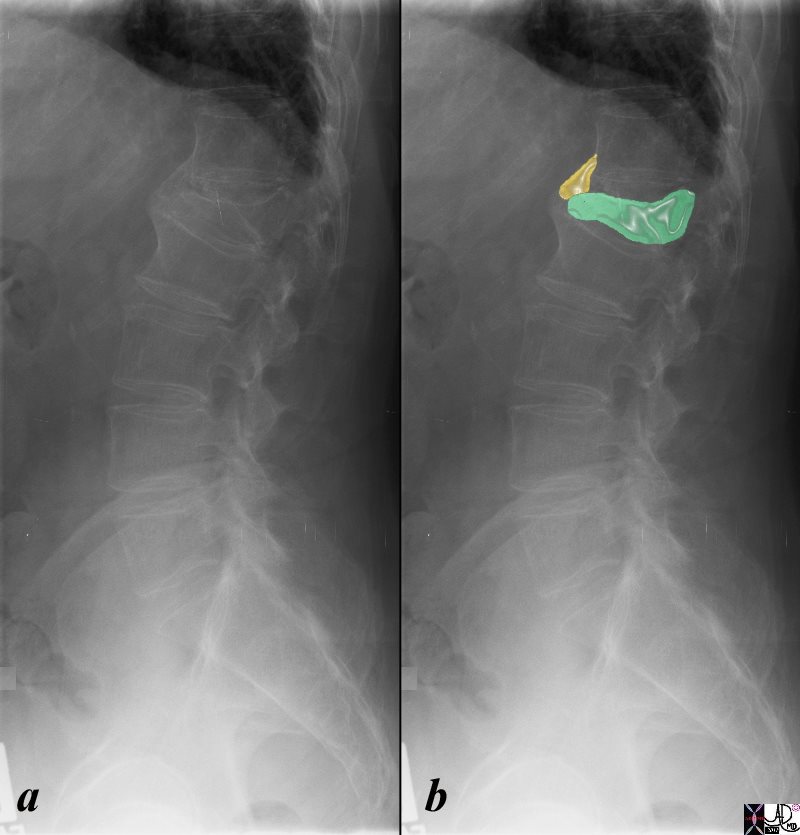
The image demonstrates a lateral projection of the lumbar spine of an 81 year old man, showing a chronic wedge shaped fracture of the first lumbar vertebra (green). The presence of a prominent bridging osteophyte (orange) suggests chronicity. The mechanism is likely a compression fracture in an osteopenic spine.
Courtesy Ashley Davidoff Copyright 2011 99889c.81sL
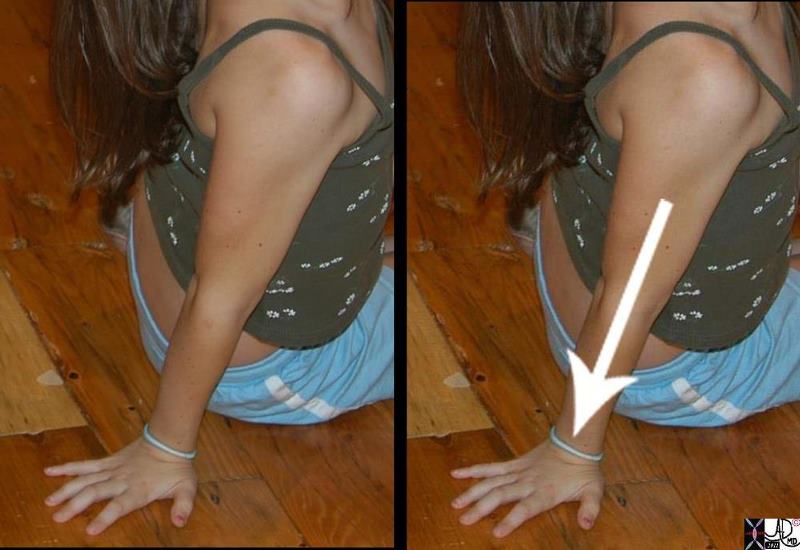
The image demonstrates the position of the wrist when a person falls backward or forward and the reflex is to flex the wrist and open the palm of the hand to break the fall. The compression and impaction pressure is placed on the distal radius and ulna, and if excessive will fracture resulting relative forward movement of the hand and backward movement of the proximal forearm The name of the fracture is a Colle?s fracture. In this instance the forces on the radius take most the impact while the ulna takes less. The anatomical position of the forearm is with the palm of the hand facing forward. In this position, the part of the forearm that faces forward is called ventral and the opposite side is called dorsal. The direction of the forces and weight pushes on the wrist so that the radius gets pushed to the anatomically named ventral portion of the forearm and the distal fragment attached to the wrist gets pushed dorsally.
Courtesy Ashley Davidoff Copyright 2011 81278pc.8s

The reconstructed CT scan of the wrist is shown in A-P (a,b) lateral (c,d) and 3D rendering (e,f). The images exemplify the pathogenesis of a compression force and subsequent impaction fracture of the shaft (orange in b,d,f) into the broader distal radius (green b,d,f). The mechanism of injury is falling on to an outstretched hand with an excessive force directed along the shaft of the radius resulting in an almost transverse fracture. In this case, the lateral examination shows near anatomical alignment, but demonstrates with impaction of the proximal radius into the distal portion.
Courtesy Philips Medical Systems 88374c02.9s

The series of images show the initial force on the bone (large red arrow in a) followed by the compressive force (small red arrows b) on the ipsilateral side of the injurious force. As the force gets transmitted through the bone tensile forces (white arrows in c) cause a distraction of the fibres of the bone.. When a pressure is applied to a long bone at an approximate right angle vector a pliable structure like bone will bend having a concave shape on the receiving end of the force and a convex shape on the opposite surface The forces on the concave side are compressive and on the opposite convexity they are tensile.(Latin tendere – to stretch).
Courtesy Ashley Davidoff Copyright 2011 106647p.84cL.91L
Shearing Forces
A shearing force is also a force that occurs along the long axis of a long bone by compressive mechanisms, but the force is then transmitted across a joint to other bones not protected by the longitudinal axis of the bone.
Avulsion Force
An avulsion force is most commonly caused by strong muscular action resulting in avulsion of a bony protuberance which is a site for attachment of the bone.
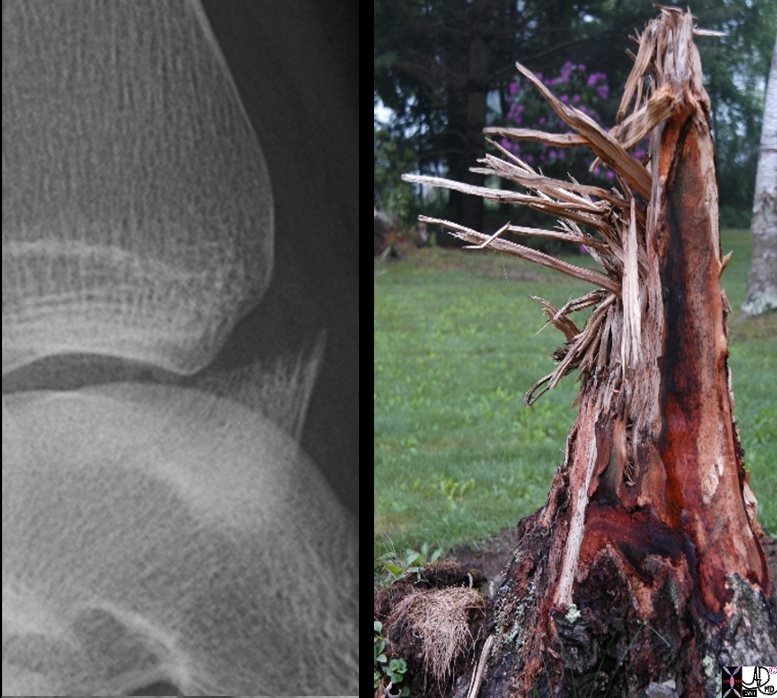
The X-ray of the ankle in a 15 year old male in the anteroposterior projection (A-P) shows an avulsion fracture of the anterior portion of the distal tibia. Note the spikes of broken bone at the edge of the distal fragment, reminiscent of the spikes of splintered tree from the weather induced fracture of this tree taken in the Berkshires Connecticut. The close relationship of the two bones in the ankle region and the presence of an interosseus membrane that binds the two bones into a single unit, makes combination fractures common.
Courtesy Ashley Davidoff Copyright 2011 99940c02
Stress Fractures
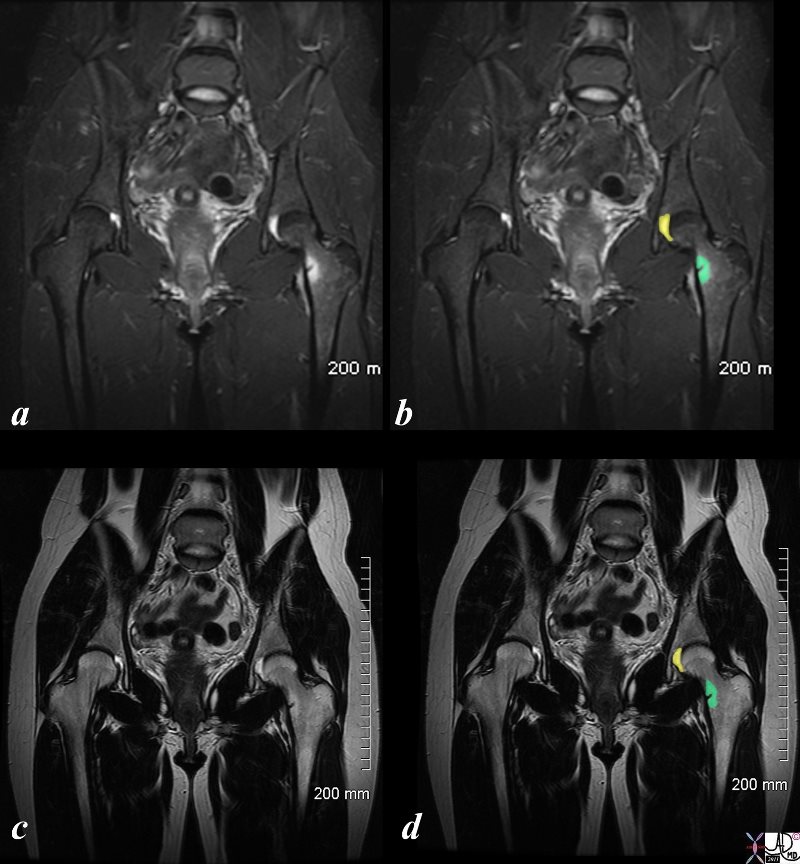
These MRI images demonstrate a stress fracture in the neck of the left femur. Images a and b are STIR images in the coronal plane while images c and d show a T2 sequence in the same plane. The fracture is characterized by a small medial positioned fracture (black) surrounded by a rim of edema (green in b and d). A small effusion is noted in the left hip (yellow)
Courtesy Ashley Davidoff Copyright 2011 82987cL01s.8
Pathological Fracture
A pathologic fracture is a fracture that occurs through weakened bone. Causes include benign conditions such as osteoporosis, focal osteomyelitis, or bone cysts. metastatic disease or primary malignant disease can also cause weakening of the bone and predispose the bone to fracture.
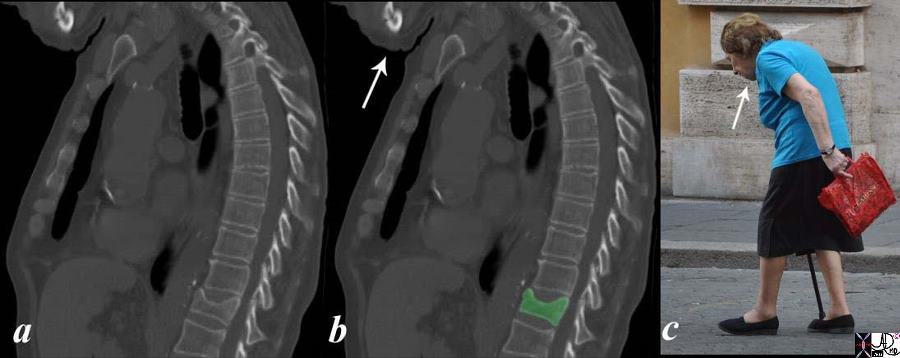
The sagittal reconstruction of a CTscan of the chest reveals a compression fracture of one of the distal thoracic vertebra in this elderly lady. This is an example of normal gravitational effects on a vertebral column weakened by osteoporosis. In image b the compression fracture is overlaid in green. The compression fracture together with slow progressive loss of height of other vertebral bodies, mostly in the anterior portions of the vertebra, results in an overall loss of height of the person and a progressive kyphosis. An elderly woman (c) suffering from the same condition, but slightly worse reveals a marked kyphosis with head and chin directed to the ground (white arrow) as a result of the kyphosis of the cervical and thoracic spine. .
Courtesy Ashley Davidoff Copyright 2011 106475pb 75657c03.9s
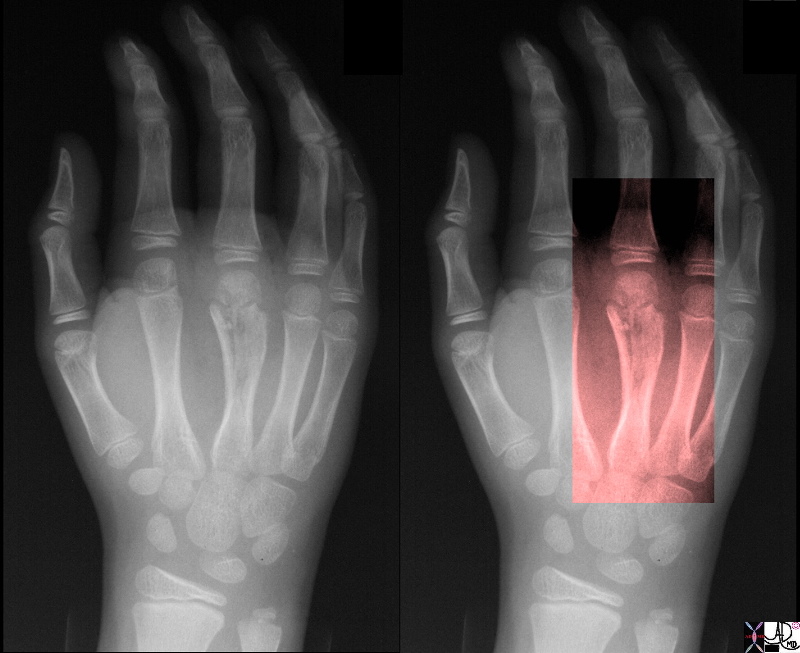
The A-P examination of the hand of a young patient with unfused epiphyses reveal a gunshot injury to the hand resulting in a shattered third metacarpal of the right hand. The distal shaft of the bone is flared with a horizontal fracture through the growth plate and fractures along the long axis of the shaft. The soft tissues are swollen and some air is noted around the fracture site . This is a example of a high velocity penetration injury
Courtesy Ashley Davidoff Copyright 2011 32754c01.8s
